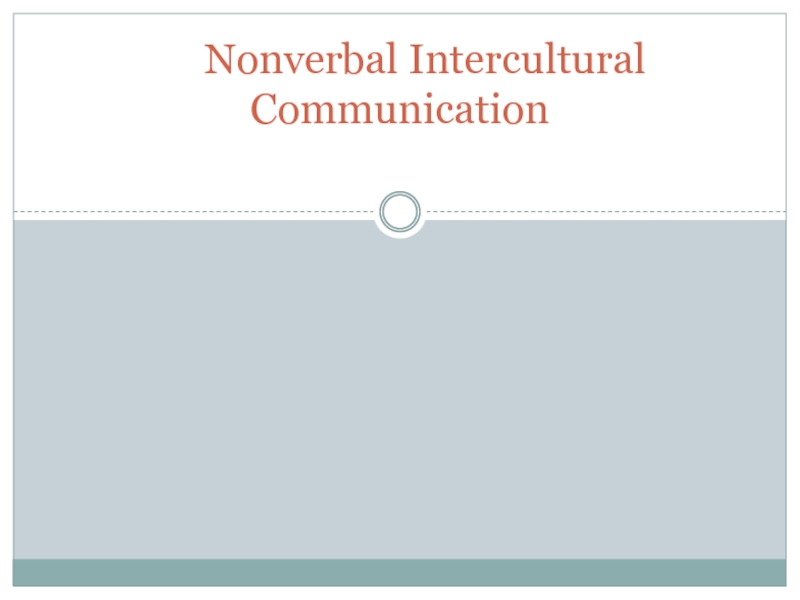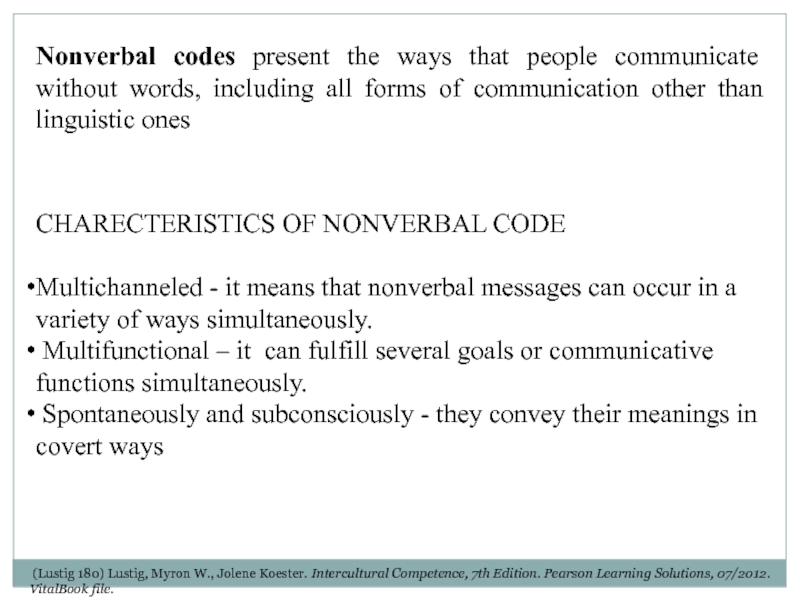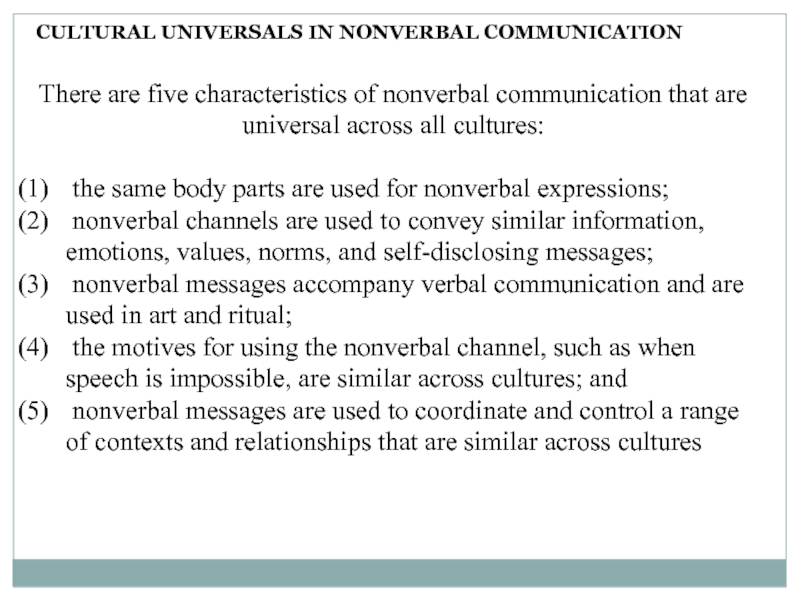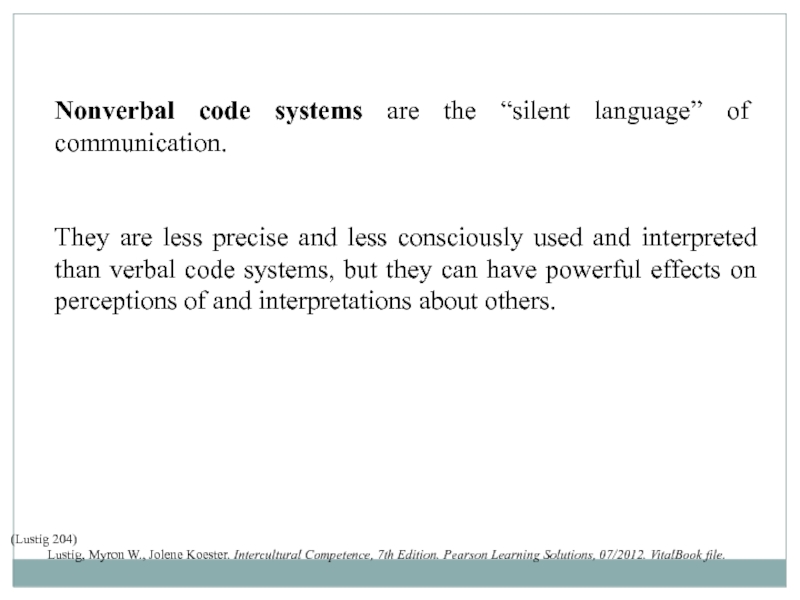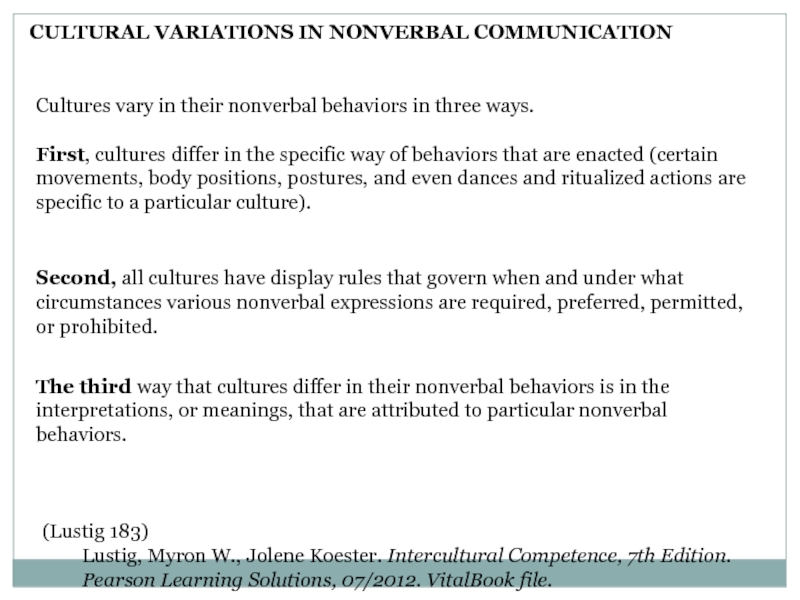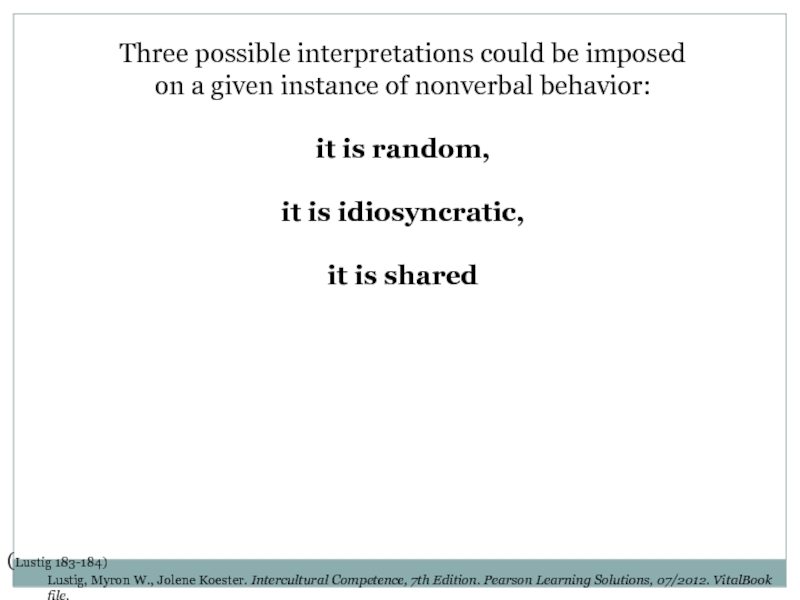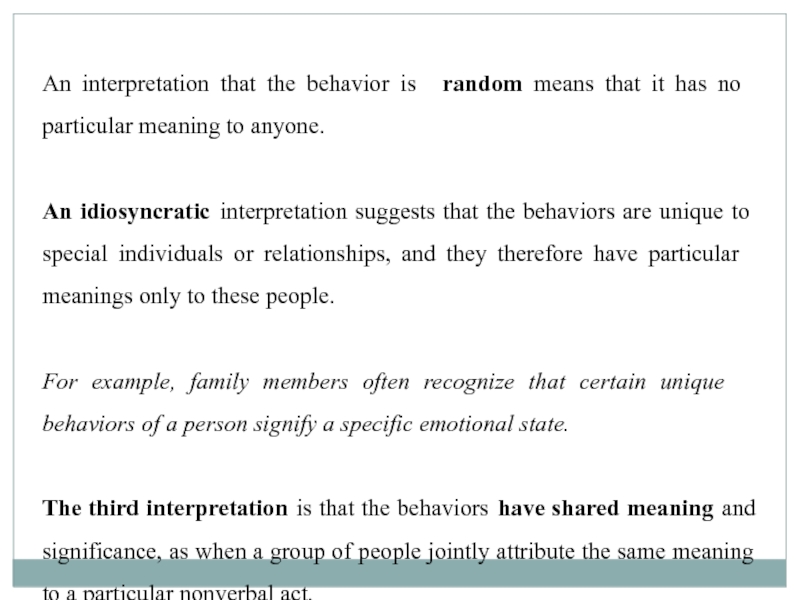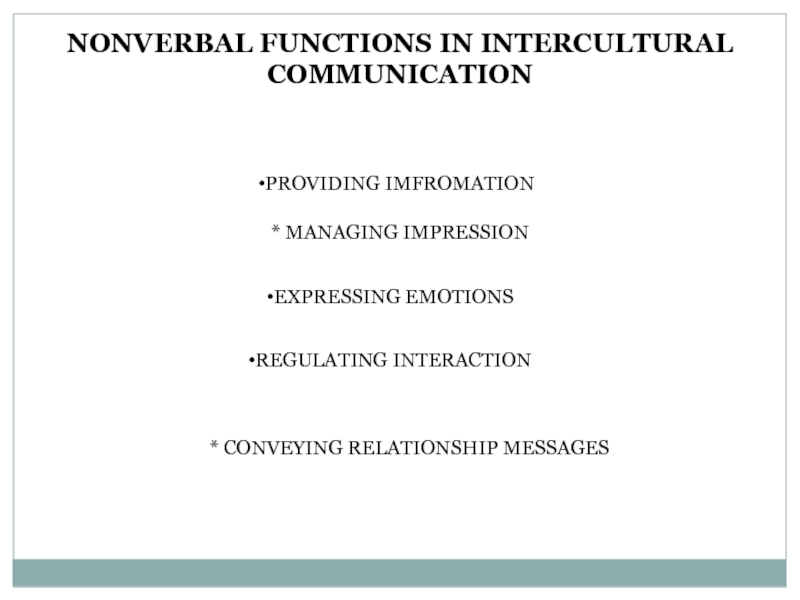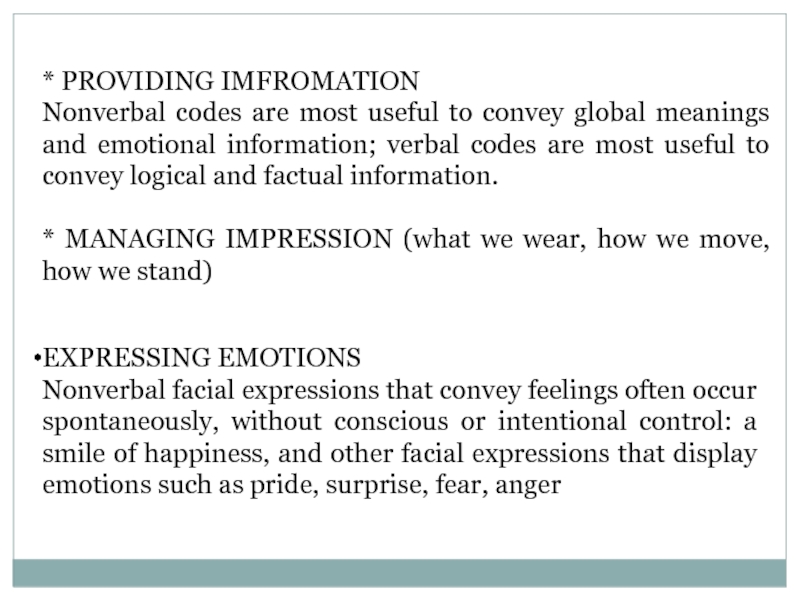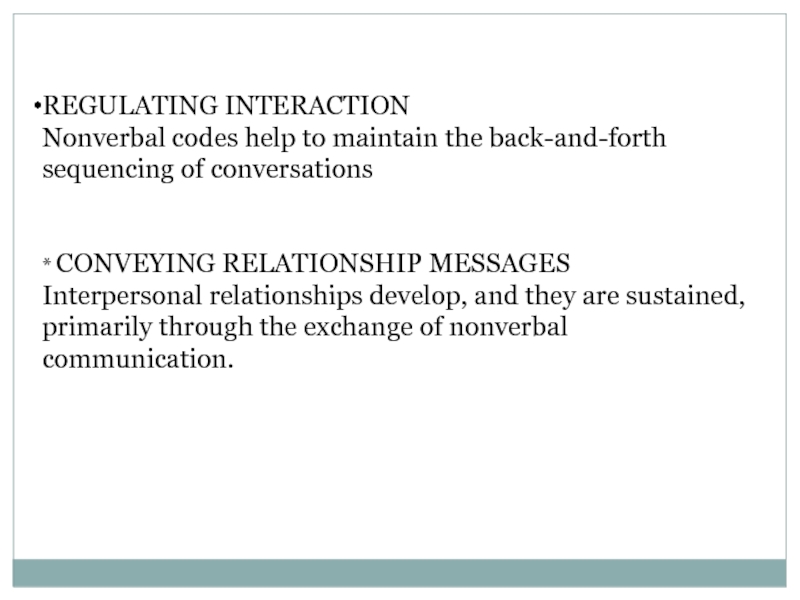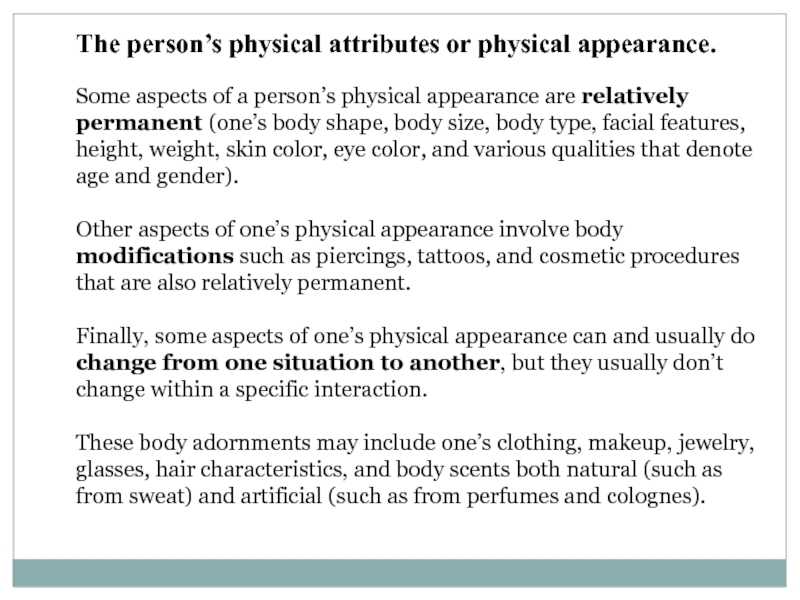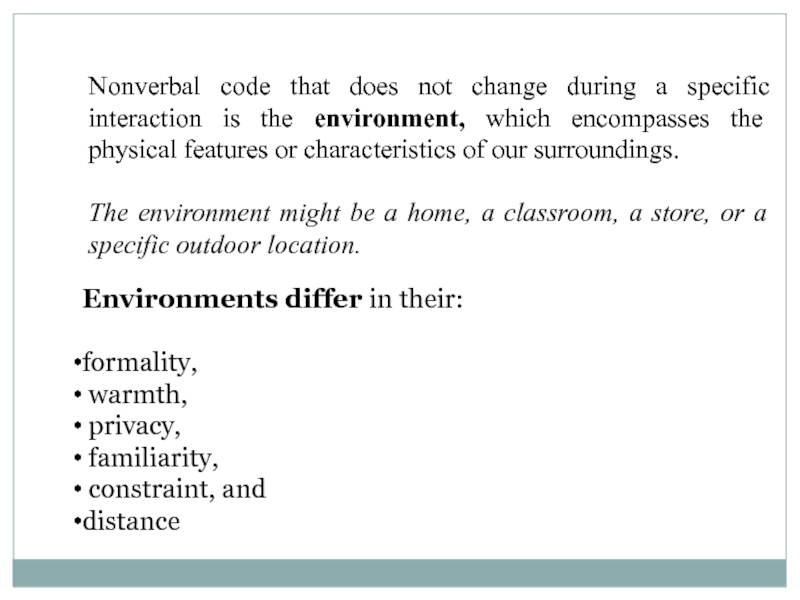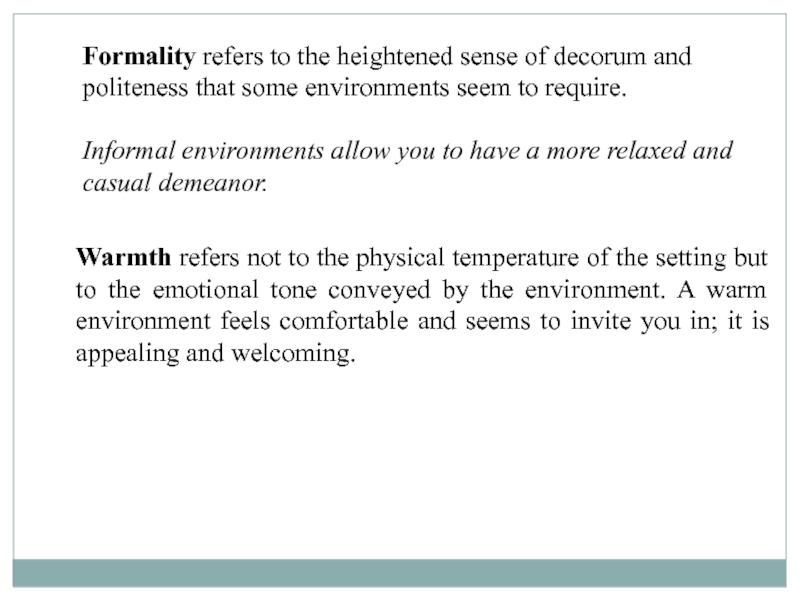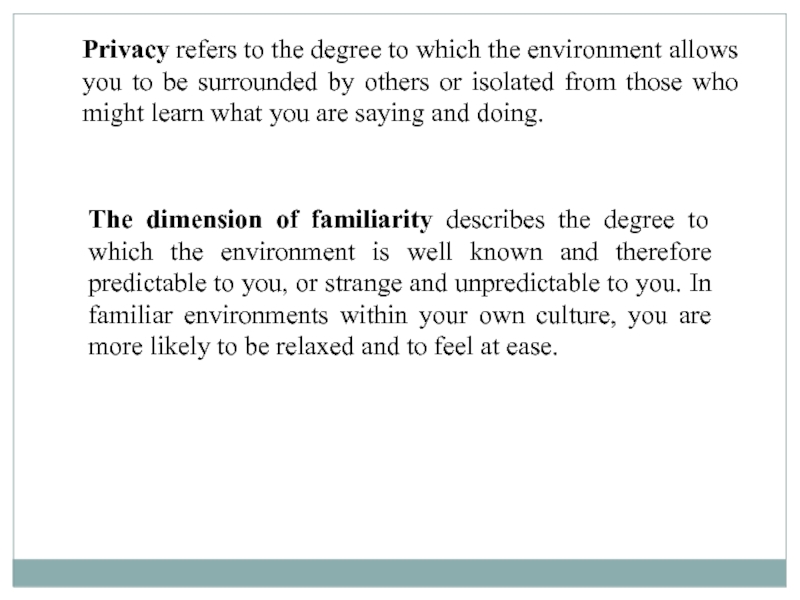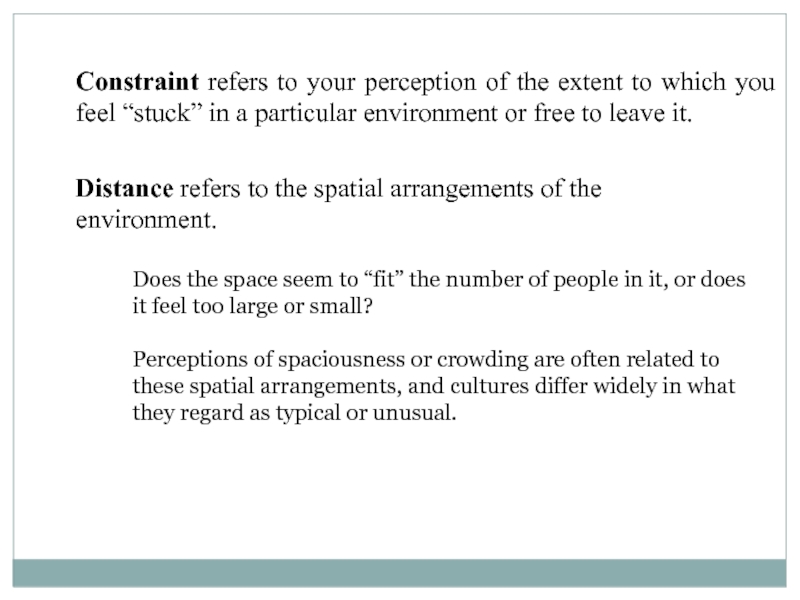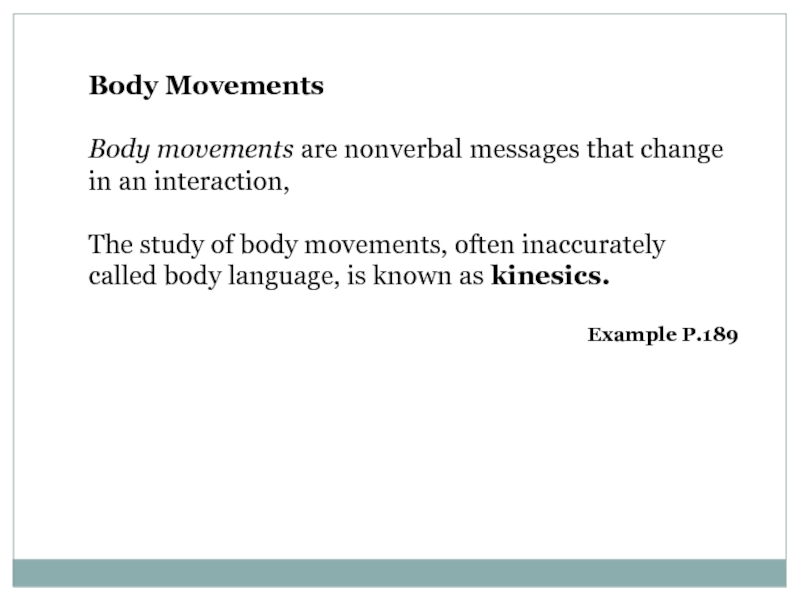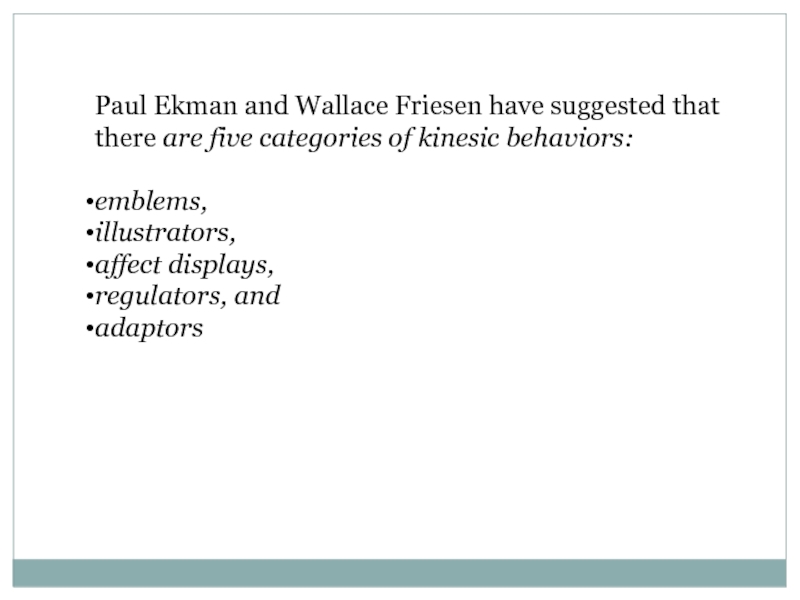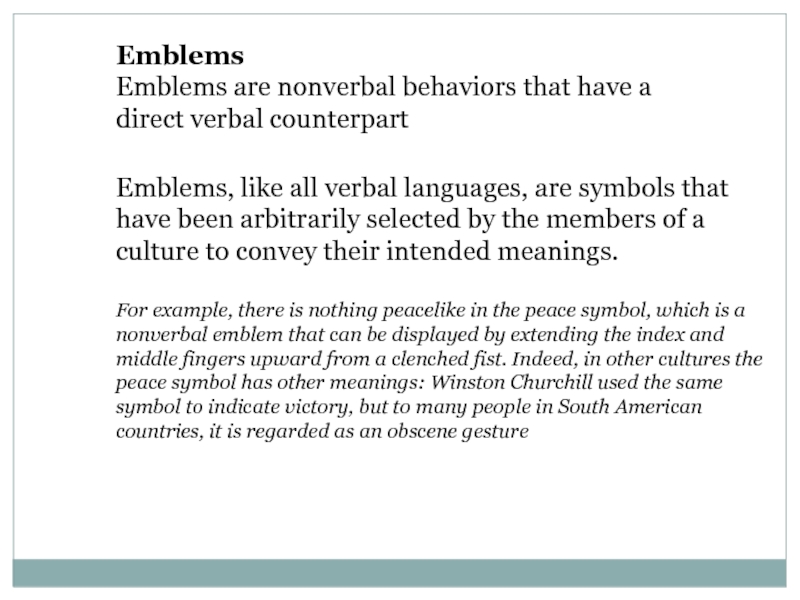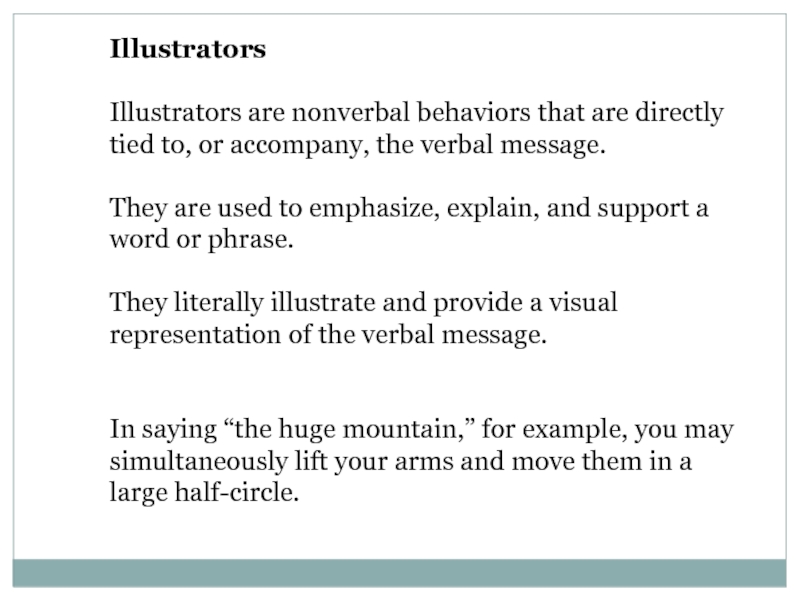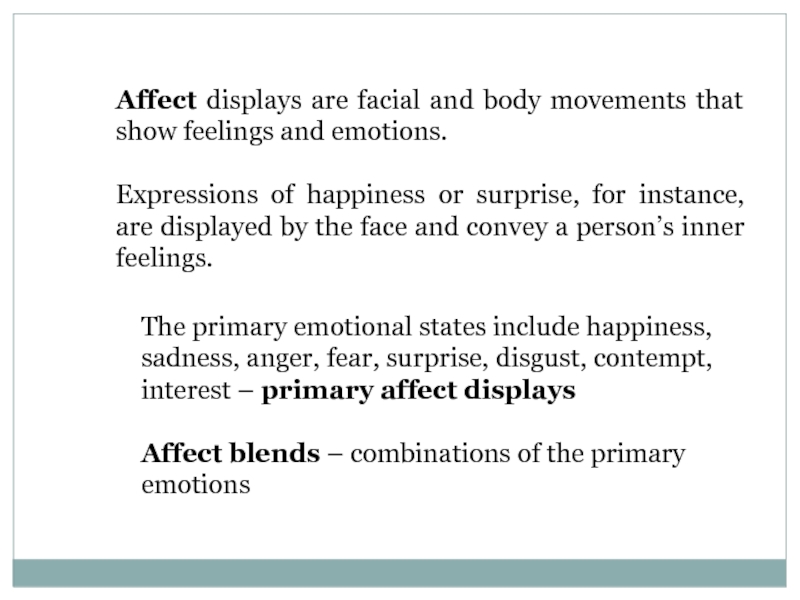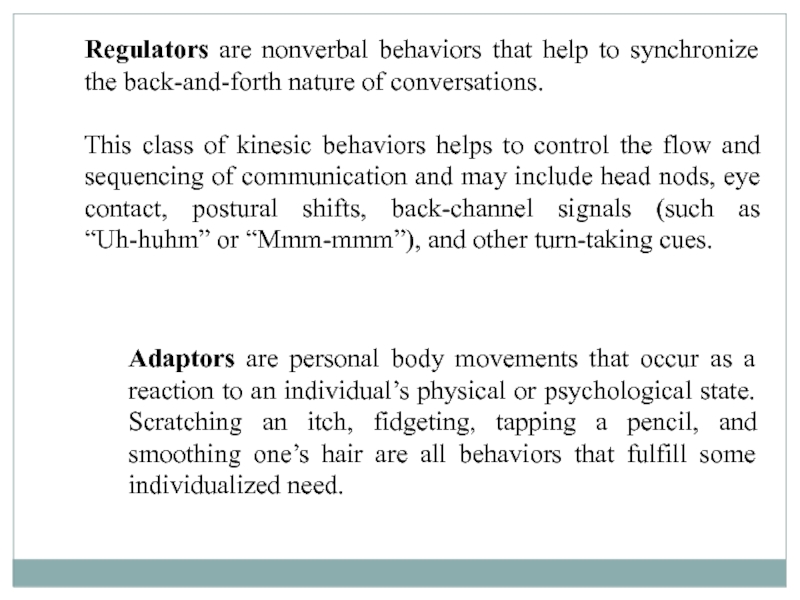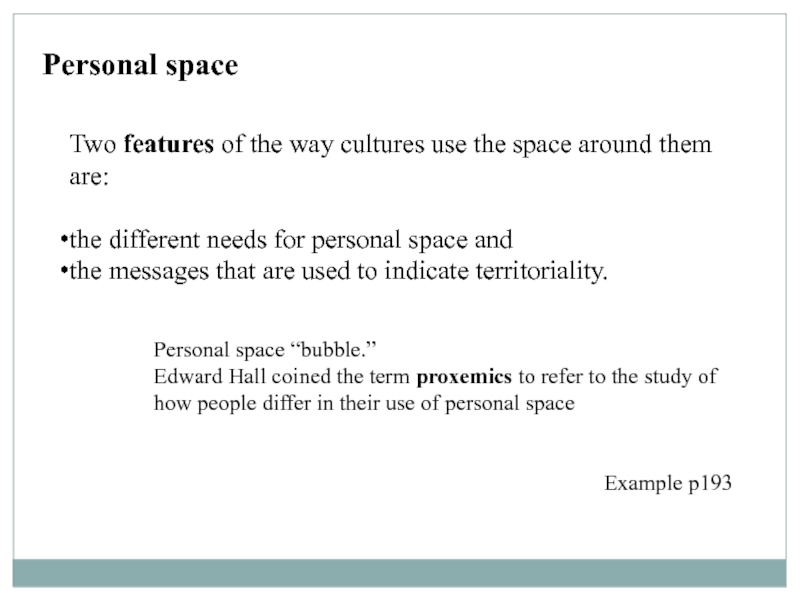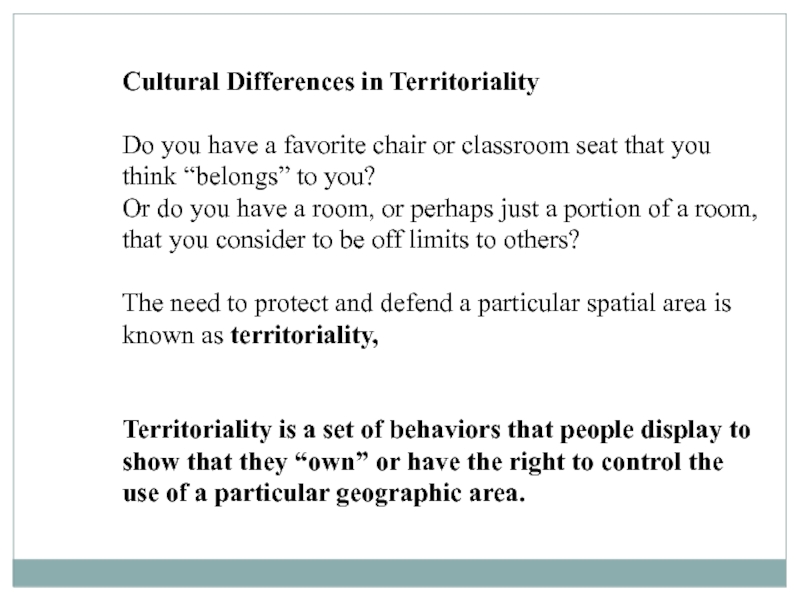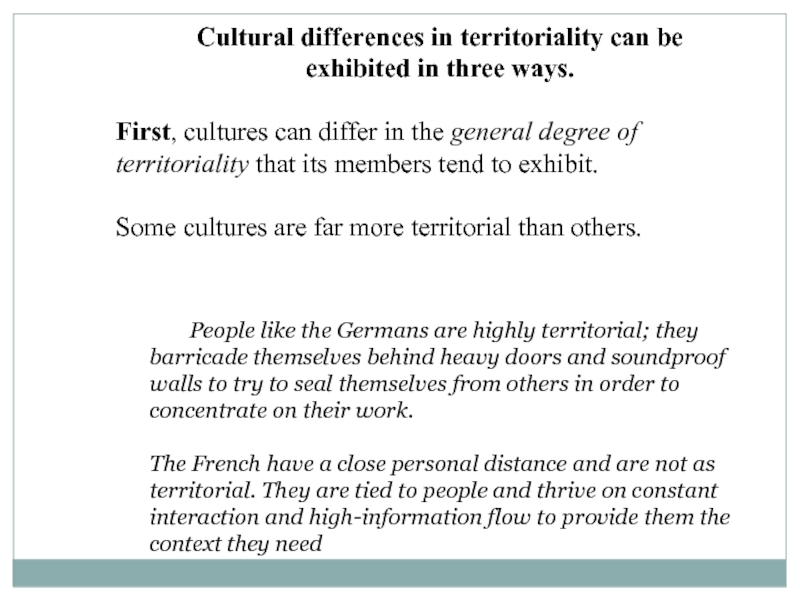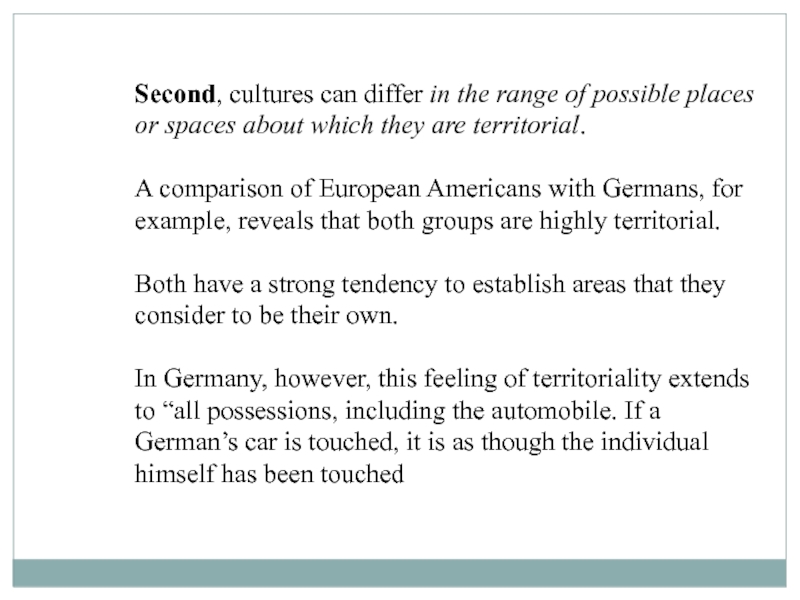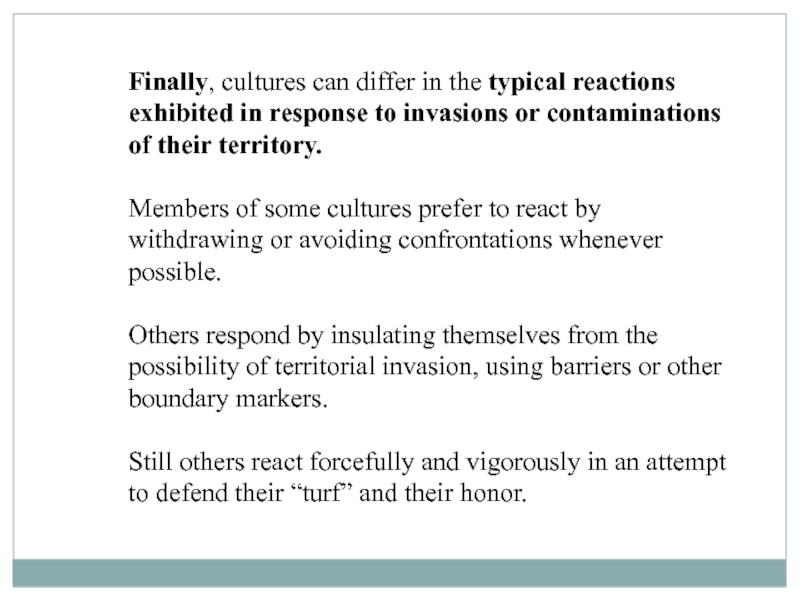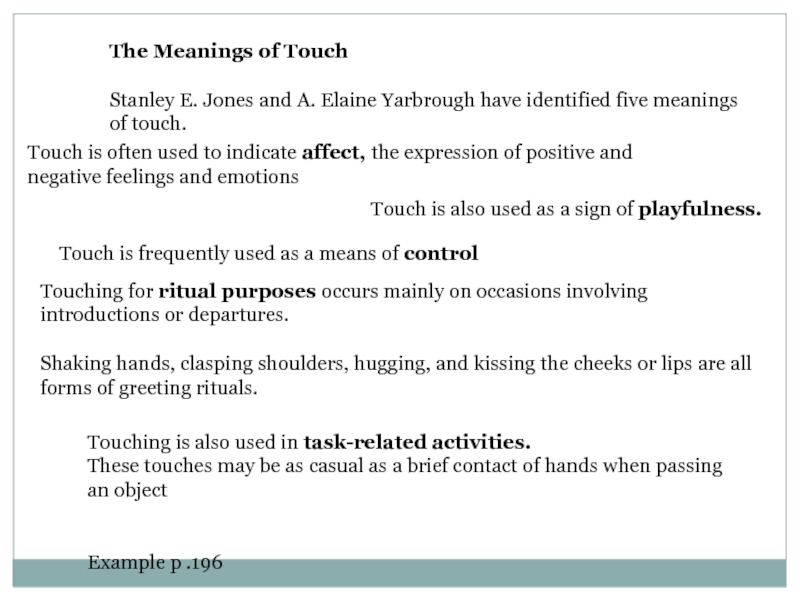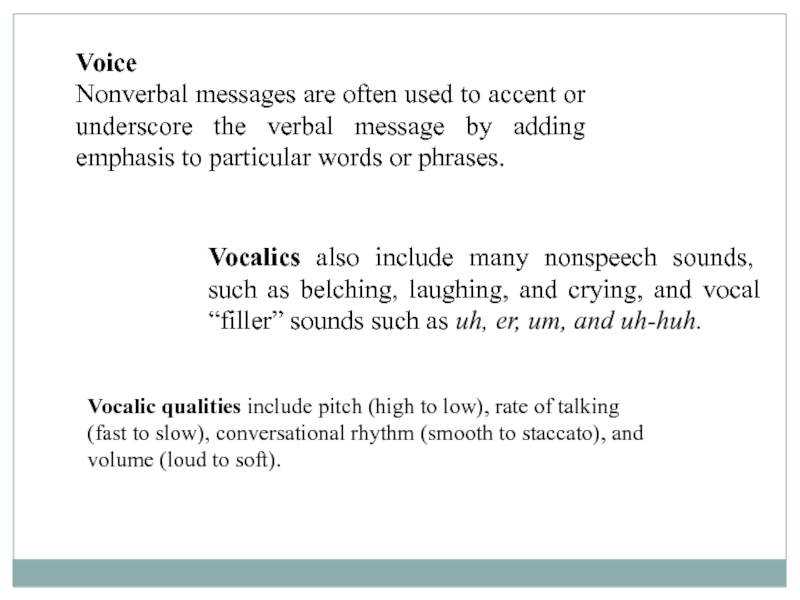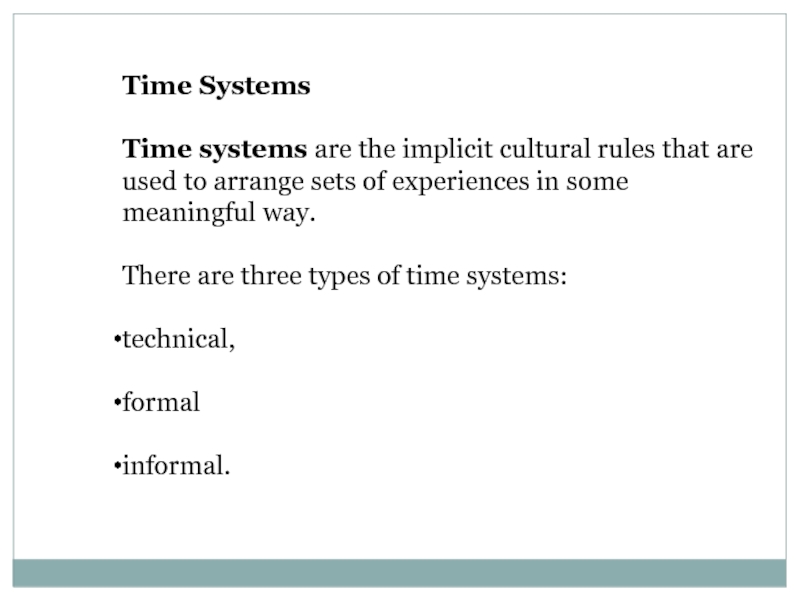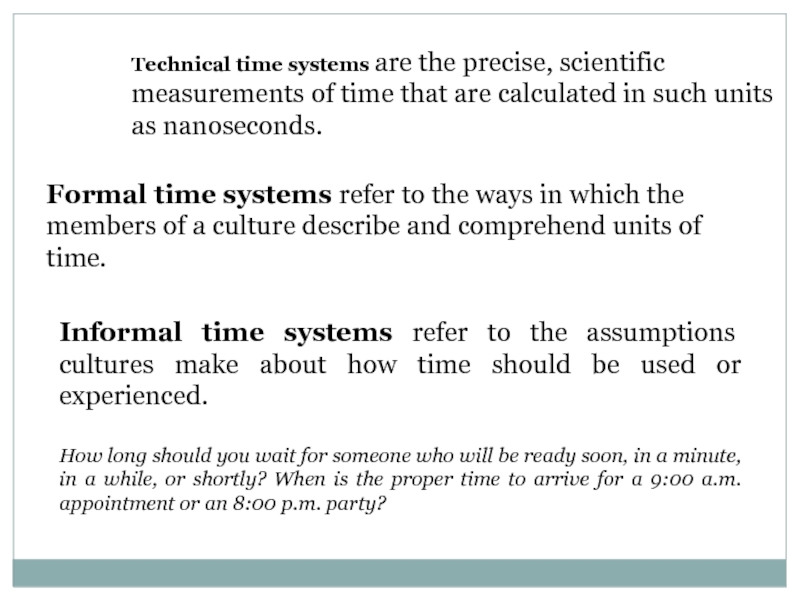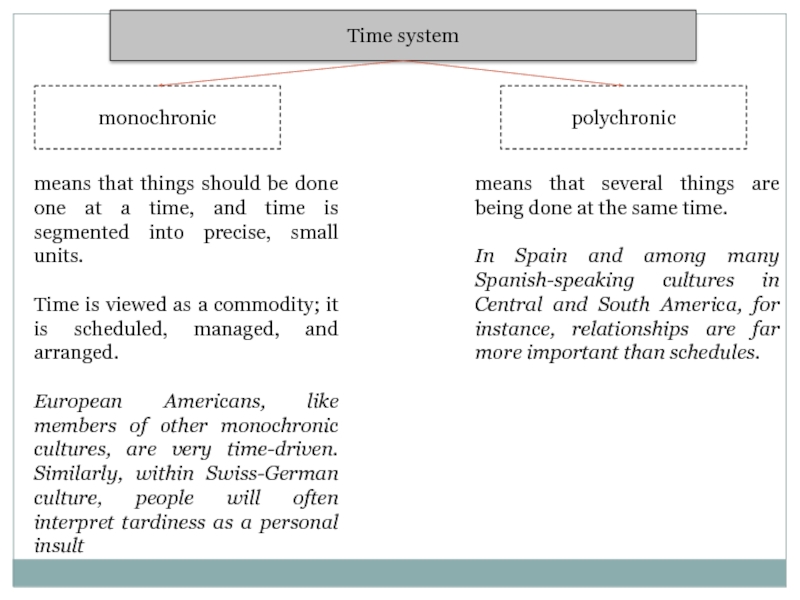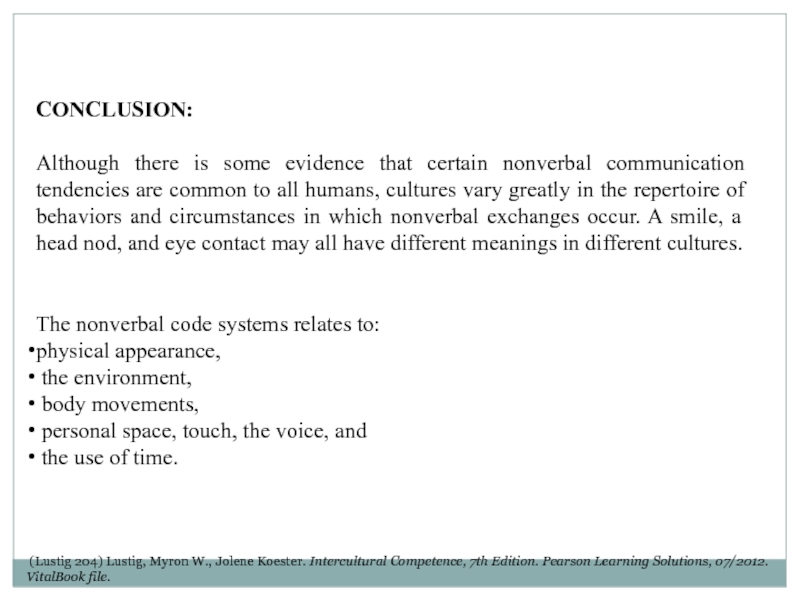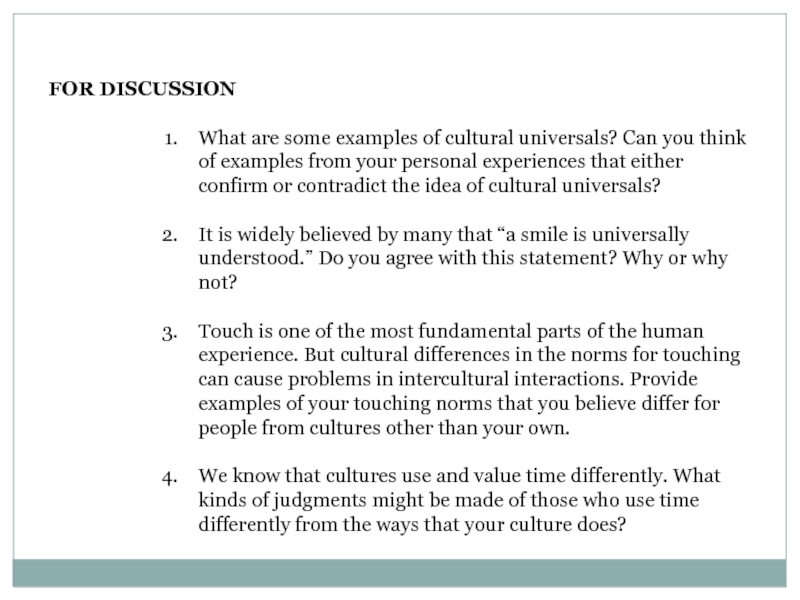- Главная
- Разное
- Дизайн
- Бизнес и предпринимательство
- Аналитика
- Образование
- Развлечения
- Красота и здоровье
- Финансы
- Государство
- Путешествия
- Спорт
- Недвижимость
- Армия
- Графика
- Культурология
- Еда и кулинария
- Лингвистика
- Английский язык
- Астрономия
- Алгебра
- Биология
- География
- Детские презентации
- Информатика
- История
- Литература
- Маркетинг
- Математика
- Медицина
- Менеджмент
- Музыка
- МХК
- Немецкий язык
- ОБЖ
- Обществознание
- Окружающий мир
- Педагогика
- Русский язык
- Технология
- Физика
- Философия
- Химия
- Шаблоны, картинки для презентаций
- Экология
- Экономика
- Юриспруденция
Nonverbal Intercultural Communication презентация
Содержание
- 1. Nonverbal Intercultural Communication
- 2. Nonverbal codes present the ways that people
- 3. There are five characteristics of nonverbal communication
- 4. Nonverbal code systems are the “silent language”
- 5. CULTURAL VARIATIONS IN NONVERBAL COMMUNICATION Cultures vary
- 6. Three possible interpretations could be imposed
- 7. An interpretation that the behavior is random
- 8. NONVERBAL FUNCTIONS IN INTERCULTURAL COMMUNICATION PROVIDING IMFROMATION
- 9. * PROVIDING IMFROMATION Nonverbal codes are most
- 10. REGULATING INTERACTION Nonverbal codes help to
- 11. NONVERBAL MESSAGES IN INTERCULTURAL COMMUNICATION Messages are
- 12. The person’s physical attributes or physical appearance.
- 13. Nonverbal code that does not change during
- 14. Formality refers to the heightened sense of
- 15. Privacy refers to the degree to which
- 16. Constraint refers to your perception of the
- 17. Body Movements Body movements are nonverbal
- 18. Paul Ekman and Wallace Friesen have suggested
- 19. Emblems Emblems are nonverbal behaviors that have
- 20. Illustrators Illustrators are nonverbal behaviors that
- 21. Affect displays are facial and body movements
- 22. Adaptors are personal body movements that occur
- 23. Personal space “bubble.” Edward Hall coined
- 24. Cultural Differences in Territoriality Do you
- 25. Cultural differences in territoriality can be
- 26. Second, cultures can differ in the range
- 27. Finally, cultures can differ in the typical
- 28. The Meanings of Touch Stanley E.
- 29. Voice Nonverbal messages are often used to
- 30. The study of time—how people use it,
- 31. Time Systems Time systems are the
- 32. Technical time systems are the precise, scientific
- 33. Time system monochronic means that things should
- 34. The nonverbal code systems relates to: physical
- 35. FOR DISCUSSION What are some examples
Слайд 2Nonverbal codes present the ways that people communicate without words, including
(Lustig 180) Lustig, Myron W., Jolene Koester. Intercultural Competence, 7th Edition. Pearson Learning Solutions, 07/2012. VitalBook file.
CHARECTERISTICS OF NONVERBAL CODE
Multichanneled - it means that nonverbal messages can occur in a variety of ways simultaneously.
Multifunctional – it can fulfill several goals or communicative functions simultaneously.
Spontaneously and subconsciously - they convey their meanings in covert ways
Слайд 3There are five characteristics of nonverbal communication that are universal across
the same body parts are used for nonverbal expressions;
nonverbal channels are used to convey similar information, emotions, values, norms, and self-disclosing messages;
nonverbal messages accompany verbal communication and are used in art and ritual;
the motives for using the nonverbal channel, such as when speech is impossible, are similar across cultures; and
nonverbal messages are used to coordinate and control a range of contexts and relationships that are similar across cultures
CULTURAL UNIVERSALS IN NONVERBAL COMMUNICATION
Слайд 4Nonverbal code systems are the “silent language” of communication.
They are
(Lustig 204)
Lustig, Myron W., Jolene Koester. Intercultural Competence, 7th Edition. Pearson Learning Solutions, 07/2012. VitalBook file.
Слайд 5CULTURAL VARIATIONS IN NONVERBAL COMMUNICATION
Cultures vary in their nonverbal behaviors in
First, cultures differ in the specific way of behaviors that are enacted (certain movements, body positions, postures, and even dances and ritualized actions are specific to a particular culture).
Second, all cultures have display rules that govern when and under what circumstances various nonverbal expressions are required, preferred, permitted, or prohibited.
The third way that cultures differ in their nonverbal behaviors is in the interpretations, or meanings, that are attributed to particular nonverbal behaviors.
(Lustig 183)
Lustig, Myron W., Jolene Koester. Intercultural Competence, 7th Edition. Pearson Learning Solutions, 07/2012. VitalBook file.
Слайд 6Three possible interpretations could be imposed
on a given instance of
it is random,
it is idiosyncratic,
it is shared
(Lustig 183-184)
Lustig, Myron W., Jolene Koester. Intercultural Competence, 7th Edition. Pearson Learning Solutions, 07/2012. VitalBook file.
Слайд 7An interpretation that the behavior is random means that it has
An idiosyncratic interpretation suggests that the behaviors are unique to special individuals or relationships, and they therefore have particular meanings only to these people.
For example, family members often recognize that certain unique behaviors of a person signify a specific emotional state.
The third interpretation is that the behaviors have shared meaning and significance, as when a group of people jointly attribute the same meaning to a particular nonverbal act.
Слайд 8NONVERBAL FUNCTIONS IN INTERCULTURAL COMMUNICATION
PROVIDING IMFROMATION
* MANAGING IMPRESSION
EXPRESSING EMOTIONS
REGULATING INTERACTION
*
Слайд 9* PROVIDING IMFROMATION
Nonverbal codes are most useful to convey global meanings
* MANAGING IMPRESSION (what we wear, how we move, how we stand)
EXPRESSING EMOTIONS
Nonverbal facial expressions that convey feelings often occur spontaneously, without conscious or intentional control: a smile of happiness, and other facial expressions that display emotions such as pride, surprise, fear, anger
Слайд 10REGULATING INTERACTION
Nonverbal codes help to maintain the back-and-forth sequencing of
* CONVEYING RELATIONSHIP MESSAGES
Interpersonal relationships develop, and they are sustained, primarily through the exchange of nonverbal communication.
Слайд 11NONVERBAL MESSAGES IN INTERCULTURAL COMMUNICATION
Messages are transmitted between people over some
Unlike written or spoken words nonverbal communication can occur in multiple channels simultaneously.
Thus, several types of nonverbal messages can be generated by a single speaker or listener at any given instant.
Nonverbal codes that are dynamic and can change during interactions:
body movements,
personal space,
touching, and
the characteristics of the voice
Слайд 12The person’s physical attributes or physical appearance.
Some aspects of a
Other aspects of one’s physical appearance involve body modifications such as piercings, tattoos, and cosmetic procedures that are also relatively permanent.
Finally, some aspects of one’s physical appearance can and usually do change from one situation to another, but they usually don’t change within a specific interaction.
These body adornments may include one’s clothing, makeup, jewelry, glasses, hair characteristics, and body scents both natural (such as from sweat) and artificial (such as from perfumes and colognes).
Слайд 13Nonverbal code that does not change during a specific interaction is
The environment might be a home, a classroom, a store, or a specific outdoor location.
Environments differ in their:
formality,
warmth,
privacy,
familiarity,
constraint, and
distance
Слайд 14Formality refers to the heightened sense of decorum and politeness that
Informal environments allow you to have a more relaxed and casual demeanor.
Warmth refers not to the physical temperature of the setting but to the emotional tone conveyed by the environment. A warm environment feels comfortable and seems to invite you in; it is appealing and welcoming.
Слайд 15Privacy refers to the degree to which the environment allows you
The dimension of familiarity describes the degree to which the environment is well known and therefore predictable to you, or strange and unpredictable to you. In familiar environments within your own culture, you are more likely to be relaxed and to feel at ease.
Слайд 16Constraint refers to your perception of the extent to which you
Distance refers to the spatial arrangements of the environment.
Does the space seem to “fit” the number of people in it, or does it feel too large or small?
Perceptions of spaciousness or crowding are often related to these spatial arrangements, and cultures differ widely in what they regard as typical or unusual.
Слайд 17Body Movements
Body movements are nonverbal messages that change in an interaction,
The study of body movements, often inaccurately called body language, is known as kinesics.
Example P.189
Слайд 18Paul Ekman and Wallace Friesen have suggested that there are five
emblems,
illustrators,
affect displays,
regulators, and
adaptors
Слайд 19Emblems
Emblems are nonverbal behaviors that have a direct verbal counterpart
Emblems, like
For example, there is nothing peacelike in the peace symbol, which is a nonverbal emblem that can be displayed by extending the index and middle fingers upward from a clenched fist. Indeed, in other cultures the peace symbol has other meanings: Winston Churchill used the same symbol to indicate victory, but to many people in South American countries, it is regarded as an obscene gesture
Слайд 20Illustrators
Illustrators are nonverbal behaviors that are directly tied to, or accompany,
They are used to emphasize, explain, and support a word or phrase.
They literally illustrate and provide a visual representation of the verbal message.
In saying “the huge mountain,” for example, you may simultaneously lift your arms and move them in a large half-circle.
Слайд 21Affect displays are facial and body movements that show feelings and
Expressions of happiness or surprise, for instance, are displayed by the face and convey a person’s inner feelings.
The primary emotional states include happiness, sadness, anger, fear, surprise, disgust, contempt, interest – primary affect displays
Affect blends – combinations of the primary emotions
Слайд 22Adaptors are personal body movements that occur as a reaction to
Regulators are nonverbal behaviors that help to synchronize the back-and-forth nature of conversations.
This class of kinesic behaviors helps to control the flow and sequencing of communication and may include head nods, eye contact, postural shifts, back-channel signals (such as “Uh-huhm” or “Mmm-mmm”), and other turn-taking cues.
Слайд 23Personal space “bubble.”
Edward Hall coined the term proxemics to refer
Example p193
Two features of the way cultures use the space around them are:
the different needs for personal space and
the messages that are used to indicate territoriality.
Personal space
Слайд 24Cultural Differences in Territoriality
Do you have a favorite chair or classroom
Or do you have a room, or perhaps just a portion of a room, that you consider to be off limits to others?
The need to protect and defend a particular spatial area is known as territoriality,
Territoriality is a set of behaviors that people display to show that they “own” or have the right to control the use of a particular geographic area.
Слайд 25Cultural differences in territoriality can be
exhibited in three ways.
First,
Some cultures are far more territorial than others.
People like the Germans are highly territorial; they barricade themselves behind heavy doors and soundproof walls to try to seal themselves from others in order to concentrate on their work.
The French have a close personal distance and are not as territorial. They are tied to people and thrive on constant interaction and high-information flow to provide them the context they need
Слайд 26Second, cultures can differ in the range of possible places or
A comparison of European Americans with Germans, for example, reveals that both groups are highly territorial.
Both have a strong tendency to establish areas that they consider to be their own.
In Germany, however, this feeling of territoriality extends to “all possessions, including the automobile. If a German’s car is touched, it is as though the individual himself has been touched
Слайд 27Finally, cultures can differ in the typical reactions exhibited in response
Members of some cultures prefer to react by withdrawing or avoiding confrontations whenever possible.
Others respond by insulating themselves from the possibility of territorial invasion, using barriers or other boundary markers.
Still others react forcefully and vigorously in an attempt to defend their “turf” and their honor.
Слайд 28The Meanings of Touch
Stanley E. Jones and A. Elaine Yarbrough have
Touch is often used to indicate affect, the expression of positive and negative feelings and emotions
Touch is also used as a sign of playfulness.
Touch is frequently used as a means of control
Touching for ritual purposes occurs mainly on occasions involving introductions or departures.
Shaking hands, clasping shoulders, hugging, and kissing the cheeks or lips are all forms of greeting rituals.
Touching is also used in task-related activities.
These touches may be as casual as a brief contact of hands when passing an object
Example p .196
Слайд 29Voice
Nonverbal messages are often used to accent or underscore the verbal
Vocalics also include many nonspeech sounds, such as belching, laughing, and crying, and vocal “filler” sounds such as uh, er, um, and uh-huh.
Vocalic qualities include pitch (high to low), rate of talking (fast to slow), conversational rhythm (smooth to staccato), and volume (loud to soft).
Слайд 30The study of time—how people use it, structure it, and understand
Past-oriented cultures regard previous experiences and events as most important (UK, China).
Present-oriented cultures. These cultures place a major emphasis on spontaneity and immediacy and on experiencing each moment as fully as possible. Present-oriented cultures believe that unseen and even unknown outside forces, such as fate or luck, control their lives (the Philippines and many Central and South American)
Future-oriented cultures believe that tomorrow—or some other moment in the future—is most important. Current activities are not accomplished and appreciated for their own sake but for the potential future benefits that might be obtained. (Europe)
Слайд 31Time Systems
Time systems are the implicit cultural rules that are used
There are three types of time systems:
technical,
formal
informal.
Слайд 32Technical time systems are the precise, scientific measurements of time that
Formal time systems refer to the ways in which the members of a culture describe and comprehend units of time.
Informal time systems refer to the assumptions cultures make about how time should be used or experienced.
How long should you wait for someone who will be ready soon, in a minute, in a while, or shortly? When is the proper time to arrive for a 9:00 a.m. appointment or an 8:00 p.m. party?
Слайд 33Time system
monochronic
means that things should be done one at a time,
Time is viewed as a commodity; it is scheduled, managed, and arranged.
European Americans, like members of other monochronic cultures, are very time-driven. Similarly, within Swiss-German culture, people will often interpret tardiness as a personal insult
polychronic
means that several things are being done at the same time.
In Spain and among many Spanish-speaking cultures in Central and South America, for instance, relationships are far more important than schedules.
Слайд 34The nonverbal code systems relates to:
physical appearance,
the environment,
personal space, touch, the voice, and
the use of time.
(Lustig 204) Lustig, Myron W., Jolene Koester. Intercultural Competence, 7th Edition. Pearson Learning Solutions, 07/2012. VitalBook file.
CONCLUSION:
Although there is some evidence that certain nonverbal communication tendencies are common to all humans, cultures vary greatly in the repertoire of behaviors and circumstances in which nonverbal exchanges occur. A smile, a head nod, and eye contact may all have different meanings in different cultures.
Слайд 35FOR DISCUSSION
What are some examples of cultural universals? Can you think
It is widely believed by many that “a smile is universally understood.” Do you agree with this statement? Why or why not?
Touch is one of the most fundamental parts of the human experience. But cultural differences in the norms for touching can cause problems in intercultural interactions. Provide examples of your touching norms that you believe differ for people from cultures other than your own.
We know that cultures use and value time differently. What kinds of judgments might be made of those who use time differently from the ways that your culture does?
